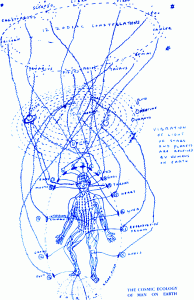 A Manual of Khsnoom – The Zoroastrian Occult Knowledge is a near 500 pages long introduction to Zoroastrian cosmology, occultism, spirituality and fantastic tales. The book is written by Phiroz Nasarvanji Tavaria assisted by Burjor Ratanji Panthaki M.A. on the basis of traditional text and it was published by Zoroastrian societies. From the book:
A Manual of Khsnoom – The Zoroastrian Occult Knowledge is a near 500 pages long introduction to Zoroastrian cosmology, occultism, spirituality and fantastic tales. The book is written by Phiroz Nasarvanji Tavaria assisted by Burjor Ratanji Panthaki M.A. on the basis of traditional text and it was published by Zoroastrian societies. From the book:
Khshnoom is not a school of philosophy or theology putting forth certain doctrines in variance with those propounded by some other such school. Khshnoom is Zoroastrianism itself. It is the occult knowledge taught by that great Religion. Religion by its very nature must have and has an occult side. It is not exaggeration to say that Religion means occultism.
The first step in this direction is to know that the world revealed to us by our five senses and understood by our three dimensional intelligence is only a very small part of the whole creation. A large part of it is beyond us, hidden from us, and cannot be known without following the prescribed directions of Religion. Let us call such hidden world as ‘the unknowable’.
Download the free complete, entire, free PDF e-book here:
 A MANUAL OF KHSHNOOM
A MANUAL OF KHSHNOOM
About Zoroastrian Occult Knowledge
The Zoroastrian Occult Knowledge encompasses a fascinating realm of esoteric wisdom rooted in the ancient religious and philosophical traditions of Zoroastrianism. With its origins dating back millennia, Zoroastrianism is one of the world’s oldest monotheistic religions, founded by the prophet Zarathustra (Zoroaster) in ancient Persia.
At the heart of Zoroastrian Occult Knowledge lies a profound understanding of the universe’s fundamental forces, the interplay between light and darkness, and the eternal struggle between good and evil. Zoroastrians believe in Ahura Mazda, the supreme deity representing truth, wisdom, and enlightenment, who combats the forces of darkness led by Angra Mainyu.
Within this framework, Zoroastrianism developed a rich tapestry of occult knowledge, rituals, and practices designed to unlock hidden truths, tap into divine energies, and navigate the complex spiritual realms. This occult knowledge is encapsulated in sacred texts such as the Avesta, which contains hymns, rituals, prayers, and philosophical discourses.
The Zoroastrian occult tradition delves into various aspects of metaphysics, cosmology, astrology, divination, and magic. It explores the intricate relationships between celestial bodies, earthly phenomena, and the human spirit. By studying these interconnections, Zoroastrian practitioners sought to gain insights into the mysteries of existence, cultivate spiritual growth, and align their lives with divine harmony.
Central to Zoroastrian occult practices is the concept of “Khsnoom” or spiritual knowledge. Khsnoom encompasses a vast array of esoteric teachings that offer guidance on the nature of the soul, the paths to enlightenment, the afterlife, and the mystical properties of various substances and rituals.
The Zoroastrian occult tradition also encompasses practices of purification, invocations, and the creation of protective amulets and talismans. These rituals aim to ward off evil, maintain spiritual balance, and ensure the individual’s spiritual and physical well-being.
While Zoroastrianism’s occult knowledge has historically been closely guarded within the faith, there is growing interest in understanding and exploring these esoteric teachings in contemporary times. Scholars, researchers, and spiritual seekers are delving into ancient texts, studying historical accounts, and engaging in dialogue with Zoroastrian communities to uncover and interpret the profound wisdom within this mystical tradition.
The Zoroastrian Occult Knowledge is a gateway to a world of ancient wisdom, offering seekers a deeper understanding of the intricate relationship between the divine, the human, and the cosmos. It invites individuals to explore their spiritual potential, embrace enlightenment, and connect with the universal forces that shape existence.


we wanna to know